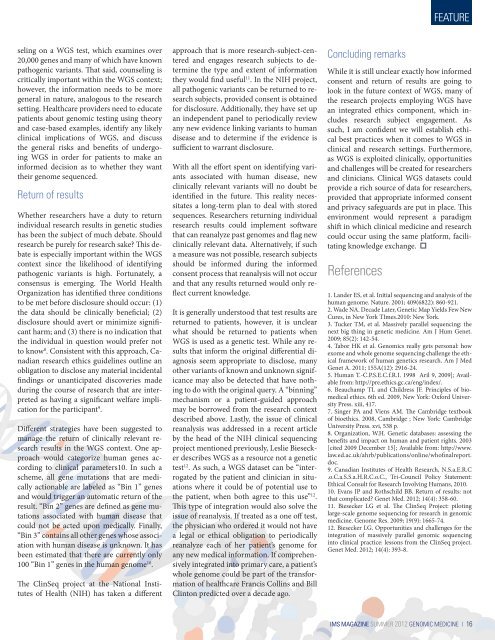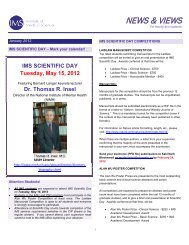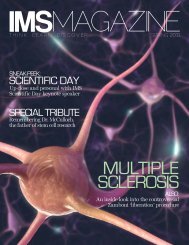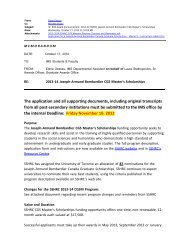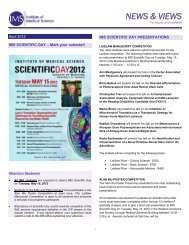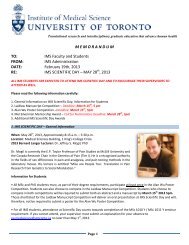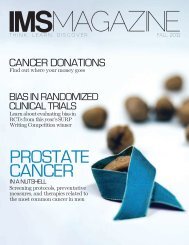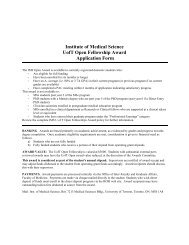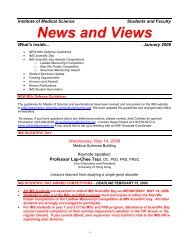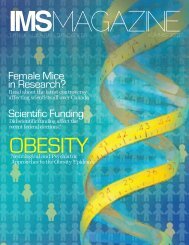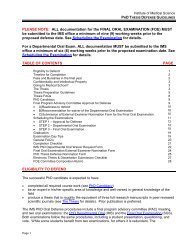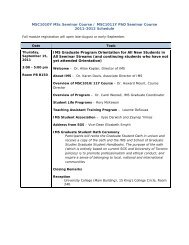IMS Magazine - Summer 2012 edition in PDF format - Institute of ...
IMS Magazine - Summer 2012 edition in PDF format - Institute of ...
IMS Magazine - Summer 2012 edition in PDF format - Institute of ...
You also want an ePaper? Increase the reach of your titles
YUMPU automatically turns print PDFs into web optimized ePapers that Google loves.
FEATURE<br />
sel<strong>in</strong>g on a WGS test, which exam<strong>in</strong>es over<br />
20,000 genes and many <strong>of</strong> which have known<br />
pathogenic variants. That said, counsel<strong>in</strong>g is<br />
critically important with<strong>in</strong> the WGS context;<br />
however, the <strong>in</strong><strong>format</strong>ion needs to be more<br />
general <strong>in</strong> nature, analogous to the research<br />
sett<strong>in</strong>g. Healthcare providers need to educate<br />
patients about genomic test<strong>in</strong>g us<strong>in</strong>g theory<br />
and case-based examples, identify any likely<br />
cl<strong>in</strong>ical implications <strong>of</strong> WGS, and discuss<br />
the general risks and benefits <strong>of</strong> undergo<strong>in</strong>g<br />
WGS <strong>in</strong> order for patients to make an<br />
<strong>in</strong>formed decision as to whether they want<br />
their genome sequenced.<br />
Return <strong>of</strong> results<br />
Whether researchers have a duty to return<br />
<strong>in</strong>dividual research results <strong>in</strong> genetic studies<br />
has been the subject <strong>of</strong> much debate. Should<br />
research be purely for research sake? This debate<br />
is especially important with<strong>in</strong> the WGS<br />
context s<strong>in</strong>ce the likelihood <strong>of</strong> identify<strong>in</strong>g<br />
pathogenic variants is high. Fortunately, a<br />
consensus is emerg<strong>in</strong>g. The World Health<br />
Organization has identified three conditions<br />
to be met before disclosure should occur: (1)<br />
the data should be cl<strong>in</strong>ically beneficial; (2)<br />
disclosure should avert or m<strong>in</strong>imize significant<br />
harm; and (3) there is no <strong>in</strong>dication that<br />
the <strong>in</strong>dividual <strong>in</strong> question would prefer not<br />
to know 8 . Consistent with this approach, Canadian<br />
research ethics guidel<strong>in</strong>es outl<strong>in</strong>e an<br />
obligation to disclose any material <strong>in</strong>cidental<br />
f<strong>in</strong>d<strong>in</strong>gs or unanticipated discoveries made<br />
dur<strong>in</strong>g the course <strong>of</strong> research that are <strong>in</strong>terpreted<br />
as hav<strong>in</strong>g a significant welfare implication<br />
for the participant 9 .<br />
Different strategies have been suggested to<br />
manage the return <strong>of</strong> cl<strong>in</strong>ically relevant research<br />
results <strong>in</strong> the WGS context. One approach<br />
would categorize human genes accord<strong>in</strong>g<br />
to cl<strong>in</strong>ical parameters10. In such a<br />
scheme, all gene mutations that are medically<br />
actionable are labeled as “B<strong>in</strong> 1” genes<br />
and would trigger an automatic return <strong>of</strong> the<br />
result. “B<strong>in</strong> 2” genes are def<strong>in</strong>ed as gene mutations<br />
associated with human disease that<br />
could not be acted upon medically. F<strong>in</strong>ally,<br />
“B<strong>in</strong> 3” conta<strong>in</strong>s all other genes whose association<br />
with human disease is unknown. It has<br />
been estimated that there are currently only<br />
100 “B<strong>in</strong> 1” genes <strong>in</strong> the human genome 10 .<br />
The Cl<strong>in</strong>Seq project at the National <strong>Institute</strong>s<br />
<strong>of</strong> Health (NIH) has taken a different<br />
approach that is more research-subject-centered<br />
and engages research subjects to determ<strong>in</strong>e<br />
the type and extent <strong>of</strong> <strong>in</strong><strong>format</strong>ion<br />
they would f<strong>in</strong>d useful 11 . In the NIH project,<br />
all pathogenic variants can be returned to research<br />
subjects, provided consent is obta<strong>in</strong>ed<br />
for disclosure. Additionally, they have set up<br />
an <strong>in</strong>dependent panel to periodically review<br />
any new evidence l<strong>in</strong>k<strong>in</strong>g variants to human<br />
disease and to determ<strong>in</strong>e if the evidence is<br />
sufficient to warrant disclosure.<br />
With all the effort spent on identify<strong>in</strong>g variants<br />
associated with human disease, new<br />
cl<strong>in</strong>ically relevant variants will no doubt be<br />
identified <strong>in</strong> the future. This reality necessitates<br />
a long-term plan to deal with stored<br />
sequences. Researchers return<strong>in</strong>g <strong>in</strong>dividual<br />
research results could implement s<strong>of</strong>tware<br />
that can reanalyze past genomes and flag new<br />
cl<strong>in</strong>ically relevant data. Alternatively, if such<br />
a measure was not possible, research subjects<br />
should be <strong>in</strong>formed dur<strong>in</strong>g the <strong>in</strong>formed<br />
consent process that reanalysis will not occur<br />
and that any results returned would only reflect<br />
current knowledge.<br />
It is generally understood that test results are<br />
returned to patients, however, it is unclear<br />
what should be returned to patients when<br />
WGS is used as a genetic test. While any results<br />
that <strong>in</strong>form the orig<strong>in</strong>al differential diagnosis<br />
seem appropriate to disclose, many<br />
other variants <strong>of</strong> known and unknown significance<br />
may also be detected that have noth<strong>in</strong>g<br />
to do with the orig<strong>in</strong>al query. A “b<strong>in</strong>n<strong>in</strong>g”<br />
mechanism or a patient-guided approach<br />
may be borrowed from the research context<br />
described above. Lastly, the issue <strong>of</strong> cl<strong>in</strong>ical<br />
reanalysis was addressed <strong>in</strong> a recent article<br />
by the head <strong>of</strong> the NIH cl<strong>in</strong>ical sequenc<strong>in</strong>g<br />
project mentioned previously, Leslie Biesecker<br />
describes WGS as a resource not a genetic<br />
test 12 . As such, a WGS dataset can be “<strong>in</strong>terrogated<br />
by the patient and cl<strong>in</strong>ician <strong>in</strong> situations<br />
where it could be <strong>of</strong> potential use to<br />
the patient, when both agree to this use” 12 .<br />
This type <strong>of</strong> <strong>in</strong>tegration would also solve the<br />
issue <strong>of</strong> reanalysis. If treated as a one <strong>of</strong>f test,<br />
the physician who ordered it would not have<br />
a legal or ethical obligation to periodically<br />
reanalyze each <strong>of</strong> her patient’s genome for<br />
any new medical <strong>in</strong><strong>format</strong>ion. If comprehensively<br />
<strong>in</strong>tegrated <strong>in</strong>to primary care, a patient’s<br />
whole genome could be part <strong>of</strong> the trans<strong>format</strong>ion<br />
<strong>of</strong> healthcare Francis Coll<strong>in</strong>s and Bill<br />
Cl<strong>in</strong>ton predicted over a decade ago.<br />
Conclud<strong>in</strong>g remarks<br />
While it is still unclear exactly how <strong>in</strong>formed<br />
consent and return <strong>of</strong> results are go<strong>in</strong>g to<br />
look <strong>in</strong> the future context <strong>of</strong> WGS, many <strong>of</strong><br />
the research projects employ<strong>in</strong>g WGS have<br />
an <strong>in</strong>tegrated ethics component, which <strong>in</strong>cludes<br />
research subject engagement. As<br />
such, I am confident we will establish ethical<br />
best practices when it comes to WGS <strong>in</strong><br />
cl<strong>in</strong>ical and research sett<strong>in</strong>gs. Furthermore,<br />
as WGS is exploited cl<strong>in</strong>ically, opportunities<br />
and challenges will be created for researchers<br />
and cl<strong>in</strong>icians. Cl<strong>in</strong>ical WGS datasets could<br />
provide a rich source <strong>of</strong> data for researchers,<br />
provided that appropriate <strong>in</strong>formed consent<br />
and privacy safeguards are put <strong>in</strong> place. This<br />
environment would represent a paradigm<br />
shift <strong>in</strong> which cl<strong>in</strong>ical medic<strong>in</strong>e and research<br />
could occur us<strong>in</strong>g the same platform, facilitat<strong>in</strong>g<br />
knowledge exchange.<br />
References<br />
1. Lander ES, et al. Initial sequenc<strong>in</strong>g and analysis <strong>of</strong> the<br />
human genome. Nature. 2001; 409(6822): 860-921.<br />
2. Wade NA. Decade Later, Genetic Map Yields Few New<br />
Cures, <strong>in</strong> New York TImes.2010: New York.<br />
3. Tucker TM, et al. Massively parallel sequenc<strong>in</strong>g: the<br />
next big th<strong>in</strong>g <strong>in</strong> genetic medic<strong>in</strong>e. Am J Hum Genet.<br />
2009; 85(2): 142-54.<br />
4. Tabor HK et al. Genomics really gets personal: how<br />
exome and whole genome sequenc<strong>in</strong>g challenge the ethical<br />
framework <strong>of</strong> human genetics research. Am J Med<br />
Genet A. 2011; 155A(12): 2916-24.<br />
5. Human T.-C.P.S.E.C.f.R.I. 1998 Aril 9, 2009]; Available<br />
from: http://pre.ethics.gc.ca/eng/<strong>in</strong>dex/.<br />
6. Beauchamp TL and Childress JF. Pr<strong>in</strong>ciples <strong>of</strong> biomedical<br />
ethics. 6th ed. 2009, New York: Oxford University<br />
Press. xiii, 417.<br />
7. S<strong>in</strong>ger PA and Viens AM. The Cambridge textbook<br />
<strong>of</strong> bioethics. 2008, Cambridge ; New York: Cambridge<br />
University Press. xvi, 538 p.<br />
8. Organization, W.H. Genetic databases: assess<strong>in</strong>g the<br />
benefits and impact on human and patient rights. 2003<br />
[cited 2009 December 15]; Available from: http://www.<br />
law.ed.ac.uk/ahrb/publications/onl<strong>in</strong>e/wh<strong>of</strong><strong>in</strong>alreport.<br />
doc.<br />
9. Canadian <strong>Institute</strong>s <strong>of</strong> Health Research, N.S.a.E.R.C<br />
.o.C.a.S.S.a.H.R.C.o.C., Tri-Council Policy Statement:<br />
Ethical Consult for Research Involv<strong>in</strong>g Humans, 2010.<br />
10. Evans JP and Rothschild BB. Return <strong>of</strong> results: not<br />
that complicated? Genet Med. <strong>2012</strong>; 14(4): 358-60.<br />
11. Biesecker LG et al. The Cl<strong>in</strong>Seq Project: pilot<strong>in</strong>g<br />
large-scale genome sequenc<strong>in</strong>g for research <strong>in</strong> genomic<br />
medic<strong>in</strong>e. Genome Res. 2009; 19(9): 1665-74.<br />
12. Biesecker LG. Opportunities and challenges for the<br />
<strong>in</strong>tegration <strong>of</strong> massively parallel genomic sequenc<strong>in</strong>g<br />
<strong>in</strong>to cl<strong>in</strong>ical practice: lessons from the Cl<strong>in</strong>Seq project.<br />
Genet Med. <strong>2012</strong>; 14(4): 393-8.<br />
<strong>IMS</strong> MAGAZINE SUMMER <strong>2012</strong> GENOMIC MEDICINE | 16


